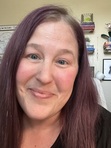Elora Nicole Ramirez's Blog, page 12
October 25, 2014
day twenty five: how to let your writing go.

When you work on a story for months — years, even — it can be difficult to let it go and allow the public to make their own decisions about it.
But you must.
You can't stand over the shoulders of those reading it and wait (im)patiently for their review. You can't respond to every misconception of plot with the real story behind why you made this character do that action (no really. Please don't respond).
You've done the work. You wrote in the early morning hours when the sun was coming up and while the moon stood watch above you. Those are your words people are reading. I get it.
Resist the fear.
There will be critics. We'll talk about them later.
Resist the fear.
.::.
When I taught poetry, I often encouraged my students to take what they would from what we read.
"Every poem is different," I told them. "You may think you don't like poetry because of what you've read before — what you know of rhyming stanzas and rhythm. But trust me. You never know when a line will knock you off your feet."
There were a few who would hold tight to their assumptions. Almost every time though, the collection of a few lines surprised them. Immediately, they found words resonating with their life. Before I knew it, they would be carrying around a poetry collection of this artist's work because "they just get me, you know?"
Yes. I do.
.::.
I doubt when Pablo Neruda wrote his poems, he thought of the hormonal high school students reading his work and applying it to their latest crush. I also doubt that when John Donne created his personas, he considered fifteen year old boys would giggle about a mosquito being used to coerce a woman into sex.
And as we write our books, we may not know the specifics of how they will be received.
There will be hopes. There will be visions of interviews with Oprah or invitations to TED or movie rights. But there is no way for us to know how our words will be received.
Do not give into the fear. When you're done writing, when you've placed the last edit in your manuscript and you've clicked the publish button on Amazon, breathe deep and let those words go.
Because now? They belong to the reader. And this is where the connections are made and your words come to life.
Need more inspiration? Introducing Hustle & Flow: a weekly letter with artistic visioning for the everyday creative. I would love it if you signed up, and I won't ever spam you. Promise.
You'll get hints and anecdotes about getting unstuck and living your most artistic life within the midst of your every day poetics. AND, if you sign up during October, you'll get some special extras dealing with indie-publishing.
October 24, 2014
day twenty four: knowing how to price

One of the questions I get the most from people who are beginning their process of indie publishing is how do I land on a price for my books?
I wish there was an easy answer.
It's not science, although there are articles about how an eBook priced at 1.99 would be the death knell for your manuscript since that price doesn't really scream CONFIDENCE. Strangely enough, 99 cent eBooks sell like hotcakes, and so do those priced at 2.99.
For me, I look around and take notes. What are other indie authors in my genre charging? You can't base your cost solely on what everyone else is doing, but you don't want to undercut or overcharge, either. I do know this: you want to have a reason for the price you've chosen.
When I released EVERY SHATTERED THING, an eBook price of 2.99 seemed fair to me. It felt good. I sent it out into the world, and then a week after publication, we bumped the price to 99 cents for a promotional sale and to see how high we could push the book on the charts. The higher the number, the more lists you find your book. Bestsellers within the subtopics of your genre, hot new releases, movers and shakers — Amazon keeps tabs of all kinds of movement within the books sold and so any jump is great.
But you want to be careful with promotions.
I only ever dropped the price twice after that initial promotion. Readers don't appreciate purchasing a book only to find the next day it's dropped price willy-nilly.
The two times I dropped EVERY SHATTERED THING's price? One was for Super Bowl weekend, one of the highest ranking weekends for human trafficking in the United States. The other was this past July. I never bumped it back up to 2.99. SOMEWHERE BETWEEN WATER AND SKY would be out within a few months, and I planned on shifting the price. I knew people new to the series would be more likely to purchase book one if it were 99 cents than if both books were 2.99. Cost analysis.
(I also dropped the paperback price of EVERY SHATTERED THING so now you can purchase it for under 10 dollars while SOMEWHERE BETWEEN WATER AND SKY is set at 14.99)
You may also consider a release week promotion. This makes sense to a lot of readers, and it boosts sales because it provides a sense of urgency. The risk here? People question why you're setting your book at such a low price. This happened to me with SOMEWHERE BETWEEN WATER AND SKY.
Also? Pay attention to royalties. With Amazon, if you price your book at 99 cents, you receive a small royalty set at 30%. If you price ABOVE 99 cents, you can change the royalty option to 70%. Huge difference.
Most important thing: what's best for you? You know your audience. You know what they'd be willing to pay. It may seem like an impossible decision, but I've found that if you think about it, the right price really does sit easy in your stomach. The wrong one? You feel dissonant. Confused. Pay attention to those feelings. You don't want to appear to the public as if you have no idea what you're doing. Stay confident. Own that story you've bled over and show others it's worth reading.
Need more inspiration? Introducing Hustle & Flow: a weekly letter with artistic visioning for the everyday creative. I would love it if you signed up, and I won't ever spam you. Promise.
You'll get hints and anecdotes about getting unstuck and living your most artistic life within the midst of your every day poetics. AND, if you sign up during October, you'll get some special extras dealing with indie-publishing.
October 23, 2014
day twenty three: teasers + Instagram

While writing SOMEWHERE BETWEEN WATER AND SKY, I did something different. I started sharing teasers of what I was working on in that moment, tagging it #realtimewriting. Every week in Story Sessions we have Teaser Tuesday, and it was a natural progression to begin sharing bits and pieces of my work as I wrote.
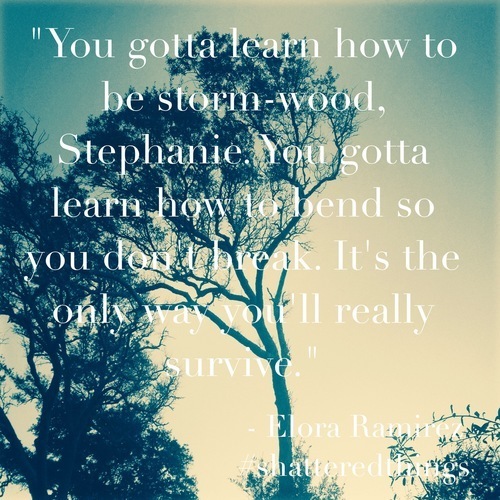
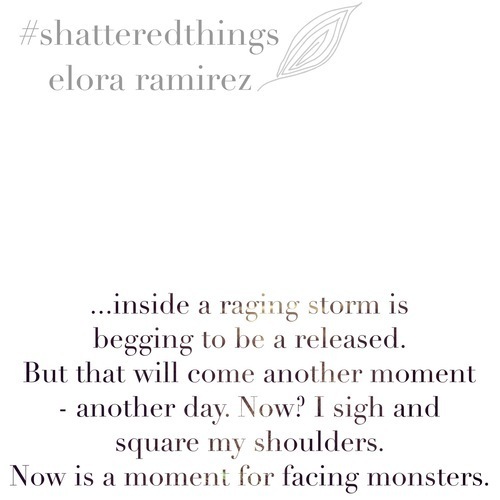
Some weeks I forgot, others I shared a few quotes, but really I just wanted to keep a steady reminder in front of people that not only am I writing a book, it's going to be available in September. I'd place this in the caption area available on Instagram.
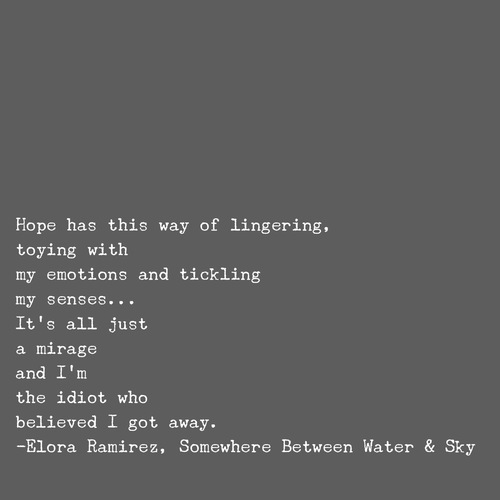
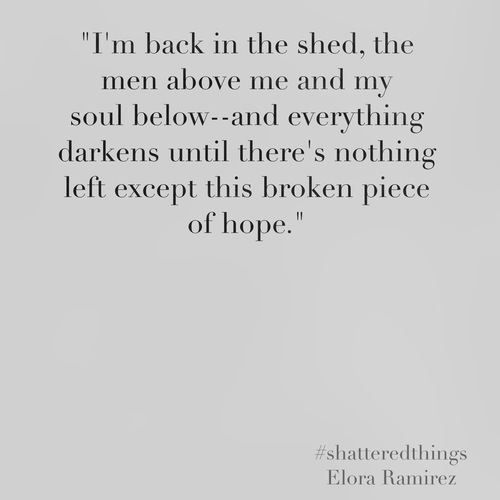
The tools I used? For a few, like the two below, I used canva. The more I work with Canva, the more I understand it, and I love they send you tutorials after you sign up. Mostly though, I used Wordswag and Instagram.
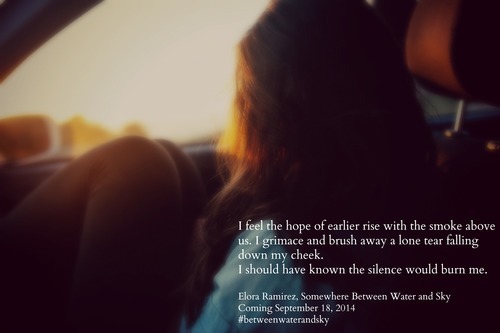
Teaser created in Canva and then shared on Facebook.
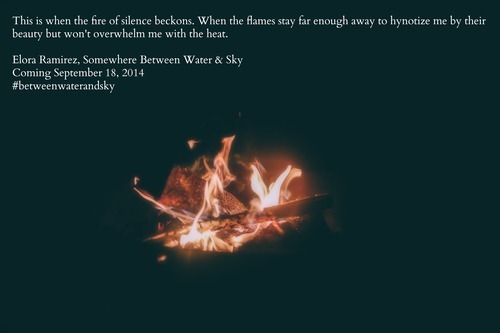
Teaser created on Canva and then shared on Facebook.
Soon, I began finding the style I wanted to stick with and most of my teasers looked the same (outside of the quote).
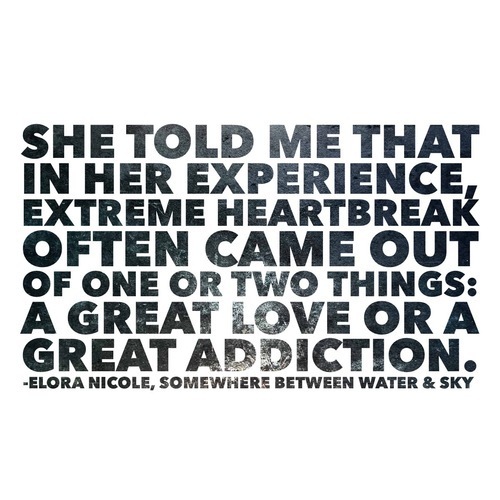
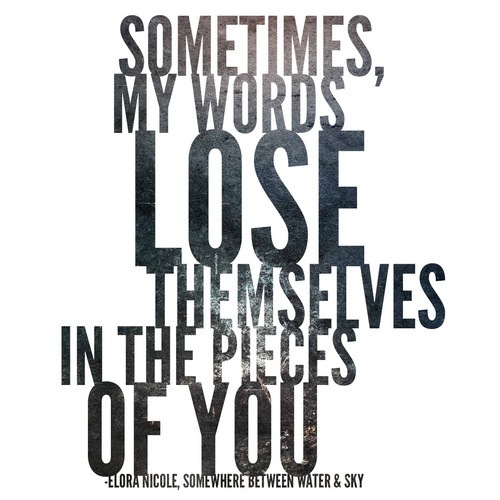
Teasers do a few things. They allow your reader a chance to see into your book before you publish. They remind others your book is coming. They create tweetable (and shareable) images + quotes for your words to spread. And, if you take full advantage of hashtagging (#amwriting, #indieauthor, #instawriters #instagood #instaquote and so much more), you can harness a simple means of marketing that works.
Pro tip: If you're using Instagram to promote your book, change the URL in your profile to the amazon link.
Need more inspiration? Introducing Hustle & Flow: a weekly letter with artistic visioning for the everyday creative. I would love it if you signed up, and I won't ever spam you. Promise.
You'll get hints and anecdotes about getting unstuck and living your most artistic life within the midst of your every day poetics. AND, if you sign up during October, you'll get some special extras dealing with indie-publishing.
October 22, 2014
day twenty two: considering your release day.

When I published EVERY SHATTERED THING, there wasn't much forethought going into a release date. I got lucky. There weren't many contemporary indie novels released that week, and so the market wasn't as saturated as it ould have been.
Things changed with SOMEWHERE BETWEEN WATER AND SKY. In the year between my two releases, there was a massive contemporary boom within the industry. Not only that, suspense + thriller became a trend. Enter book two.
Finding a release date for my second book proved difficult because I juggled a lot of timelines outside of my own: my editor, my cover artist, the cover reveal, the availability of my PR crew, and the release of other books. Originally, I looked at a publishing date in August. Because of my cover not being complete until end of July (maybe) beginning of August, and because a bunch of books were being released those last two weeks of August, I decided to release the book in September.
Once I knew the range of dates I could look at (within first few weeks of the month). I did some research on anticipated releases for my genre. There were a lot, even after the crazy amount released in August. Because of this, I knew the market was saturated which meant sales could possibly be a fraction of what my first book offered. This was good to know, because within the market I'm still a very, very young author. My audience is small compared to most, but it's growing. I had a choice: either wait until the market slowed down, or publish anyway.
Here's the thing — there will always be book releases.
Setting a release date before you even finish the book is the best way to go because it builds in accountability. However, if you've written your book and are now looking for the perfect date to release, pay attention to your market.
What are the bestsellers? Who are those authors? What books are being released around the time you want to publish? Are you doing a cover reveal at all? When?
The more intentional you are about your process and marketing strategy, the more focused you'll feel during the writing + publishing stages.Need more inspiration? Introducing Hustle & Flow: a weekly letter with artistic visioning for the everyday creative. I would love it if you signed up, and I won't ever spam you. Promise.
You'll get hints and anecdotes about getting unstuck and living your most artistic life within the midst of your every day poetics. AND, if you sign up during October, you'll get some special extras dealing with indie-publishing.
October 21, 2014
day twenty one: creating your A-team

On day six, I spoke of giving yourself deadlines.
I have found the best way to meet these deadlines and see them as real and not fabricated or willy-nilly?
Create an A-team.
For me, this looks like beta readers, critique partners, editors, cover artists, PR-mavens, and bloggers.
Aside from my husband (who's also definitely part of my A-team), beta readers and critique partners make sure I get the book done. They expect updates. They want me to publish the best book possible, and so they challenge me with my writing. They get excited for me and never tell me to give up. These are my ass-kickers and cheerleaders, and they are my first layer of sharing my story with the world.
My editor is the second layer. She's also encouraging, but realistic. If a scene needs rewriting, she won't let me get away with mundane description or passive dialogue. She knows I want excellence for the narrative, and so she helps me get there. She considers universality and helps me reach for resonance so the reader (read: people I've never met before) can find my book and love it just as much as the people who know me and want to support me.
Finding a good cover artist is just as important as any piece of the indie puzzle. Regardless of what people say, they judge a book by its cover. Snag a designer who can create a cover that takes people's breath away, and you've battled much of people's misconceptions about indie authors. esist the urge to create a cover yourself. Unless you have design experience, this is never a good idea. Trust me. I've done it.
Once I have the edits done and my beta readers have read the book once or twice or ten times, and once I get to see the cover that makes me all teary eyed with emotion, it's time to consider my PR strategy. Over the past year and a half, I've learned priceless information from Inkslinger PR, who I trust with blog tours, cover reveals, and release day magic. When I wanted to share my cover the second I got it, Kelly stopped me. When I wanted to drop my price forever, Kelly stopped me. She asks me the important question: why? And with my answer + her PR staff, we're able to create a beautiful plan for each release. My PR team is the second to last layer because they connect me with those who will read my book first and tell others about it.
Those beautiful souls are the bloggers. We cover this later, but without the bloggers, I would have no book. Bloggers tell the truth. They are the zealots behind the stories that capture your heart. I've had difficult reviews; I've had rave reviews. And you know what? Every time a review passes my feed I say a little breath of thanks. I know it in my bones: I would not be where I am today had it not been for bloggers who shared EVERY SHATTERED THING with their audience.
Who do you have in your corner? Who is cheering you on in the stands? These layers are vital when you reach the stage of marketing, because it can be so difficult to wade these waters alone. Find your people. Love them well.
And keep writing.
Need more inspiration? Introducing Hustle & Flow: a weekly letter with artistic visioning for the everyday creative. I would love it if you signed up, and I won't ever spam you. Promise.
You'll get hints and anecdotes about getting unstuck and living your most artistic life within the midst of your every day poetics. AND, if you sign up during October, you'll get some special extras dealing with indie-publishing.
October 20, 2014
day twenty: owning your story

How do I fight the trap of jealousy?
I take steps in owning my story.
For months, I hesitated in sharing that I was writing a novel. I knew if I mentioned I was writing, the immediate question would be what is your book about?
And then I'd have to tell them.
I feared ridicule. I anticipated people would consider me twisted and question my sanity in diving deep into the subject of human trafficking. I began questioning myself — wondering where this story was coming from and if I could even write something...I don't know...happy.
The pattern began: silence, comparison, confusion, loss of inspiration.
I stopped writing.
But then, I went to STORY and heard Andrew Klavan speak and was reminded —
stories are meant to be dangerous.
So I gained a little confidence. Started speaking up a little more when I was with other people and they asked me about writing.
Slowly, I began owning the story within — and getting excited about it, even. I stopped paying attention to other people and what they were creating and started focusing on the work I had yet to finish.
.::.
"Tell me about this book." I looked at her and smiled. We were skyping and I couldn't wait to find out more about what pulsed behind these dynamic characters she was creating.
"Oh...I don't know," she hesitated. "I get a little embarrassed when I tell people because it just seems like a silly idea. Like instead I should be writing about the dichotomy of good and evil — and not this."
"Huh." I paused for a moment. "Tell me more about that — why do you get embarrassed?"
She threw up her hands. "I just...I don't know, really. I don't I'm not supposed to care, but it just seems like a silly topic for a grown woman to write..."
I thought about that moment in Andrew Klavan's session a few years ago and the freedom I felt when I realized I could really write what I wanted to write. I knew that feeling of wanting so desperately others to understand the why behind my novel and the inherent fear that others would reject me simply because of the plot.
I recognized myself in the questioning gaze of this friend.
"You have to own your story." I whispered. "You have to embrace these characters. Once you do your depth of understanding for this narrative will shift dramatically. You won't be concerned about everyone else and silently censoring yourself. You won't be comparing your book to another. You'll simply be telling your story, and people who love it will love it because of that very reason."
.::.
One day, you'll be marketing your book. You'll be expected to talk about this story you've written constantly. People will ask you for guest posts and interviews and book signings — and each time, you'll have to harness that belief in the story itself.
Because you have a story. You can't forget that — you have a story worth telling. This is more than just a pep-talk in helping you understand why you should share your book with others. This is the gut-level reminder that these stories you're writing are being written for a reason.
What is a story if it's not going to be shared?
What is a story if the teller is scared?
People will notice this belief in you. They'll see the difference in how you approach talking about the stories you have inside. You won't be this cowering creative anymore whispering about the book that's not really finished and probably won't amount to anything anyway...you'll be sharing your heart and celebrating your strengths.
This is where the magic begins.
Need more inspiration? Introducing Hustle & Flow: a weekly letter with artistic visioning for the everyday creative. I would love it if you signed up, and I won't ever spam you. Promise.
You'll get hints and anecdotes about getting unstuck and living your most artistic life within the midst of your every day poetics. AND, if you sign up during October, you'll get some special extras dealing with indie-publishing.
October 19, 2014
day nineteen: the trap of jealousy

Writing can be a pretty desperate endeavor, because it is about some of our deepest needs: our need to be visible, to be heard, our need to make sense of our lives, to wake up & grow & belong - Anne Lamott
There was a season in my life where despite my greatest efforts, I couldn't be happy for the fellow writers in my life when they gained notoriety. I'd hear about some blogging award or possible publishing deal or various other recognitions and I could feel the heat of jealousy creep into my bones.
This isn't a fun way to live.
Especially when every where I turned, someone else was getting noticed in a field where I desperately wanted to be seen.
Jealousy is a trap for numerous reasons, but mostly because it keeps you from creating. In those moments where I'm feeling confused and frustrated and disgusted — both at my reaction and the success of another person — there is no room left for artistic connection.
Jealousy opens wide the door for comparison, and when I compare, I lose my inspiration. When I compare, I lose sight of the story that's my own and begin to share the story of another person, wearing it as though it fits.
It never does.
Now, I know that jealousy can serve as a map. That often, when I feel that white-hot rush filling my chest, I can trace the roots back to something within myself.
So the jealousy surrounding a friend's publishing deal really points to the discontent within myself that I haven't been writing like I know I should. Or the other friend snagging a spot on the bestseller list forces me to ask myself if I'm owning my story in the way I am meant to own it.
Because the truth? I have everything I need to be seen and belong. There are people within arm's reach who love and support me and listen as I brainstorm and vent and plot and process through my words. And when I resist jealousy's pull of taking me over completely and instead choose to celebrate the success of a fellow writer, the belonging follows.
We're all in this together. Different stories — different paths — but each and every one of us knows the threat of rolling our eyes when (fill in the blank) gets another deal or when (fill in the blank) gets recognized. That's when the fragmentation occurs. That's when confusion sets in to our bones. We begin to question and give up and kick ourselves restless because why?
Often, it's because we're not fully allowing our story to take root as it needs to — we're comparing someone else's notes with our own and expecting us to be on the same page.
When really, we're nowhere close. Two different people with two different stories who happen to hold the same heartbeat: the way words make us feel as we spill them on the page.
Need more inspiration? Introducing Hustle & Flow: a weekly letter with artistic visioning for the everyday creative. I would love it if you signed up, and I won't ever spam you. Promise.
You'll get hints and anecdotes about getting unstuck and living your most artistic life within the midst of your every day poetics. AND, if you sign up during October, you'll get some special extras dealing with indie-publishing.
October 18, 2014
day eighteen: how to listen to your story.

You can bully your story into where you want it to go.
You are the author after all. You hold the power. Your hands can hesitate before typing the sentence. You may feel the burn — what it feels like when a character comes alive inside of you and pushes out through your fingertips —
but you don't have to answer their call.
You don't have to listen.
But if you want your story to sprout wings, hunker down for the whisper.
At first, I manipulated my characters in EVERY SHATTERED THING. In fact, for a brief moment, that story was pushed out into the world before it was time and the result was a shoddy script of a manuscript and an ending that was fabricated out of what I thought other people would want to read.
Meaning, I didn't listen to my story.
When my publisher went under and I got my rights back, it was the most perfect kind of kismet. I snatched the book off the shelves quick, fast and in a hurry and I rewrote the scenes that left me feeling achy because I didn't listen to my gut. I stayed true to Stephanie's character. I stopped caring what others would say. I sat at the computer and waited for her to speak and then — and only then — did I begin to write.
This was where the new ending was born.
And you know what? I experienced more flow in that editing process than I did in the last year and a half of writing and trying to wrangle the plot into submission. Allowing it to take shape and giving the characters freedom to act out of their own personality (and not the manufactured version I wrote the first time around) gave me insight into how so often we can allow a story to leave our hands before we've had the chance to really understand the characters.
So you can choose to ignore the whispers of plot and story and character while writing. Your manuscript won't be as strong as it could be though if you just let the book speak.
Listen. Get quiet and away from all of the distractions and people telling you what makes a good story and how to engage readers with this type of scene and yada-yada-yada —
and make sure your story speaks.
Without it, readers will never know the power of your words.
Need more inspiration? Introducing Hustle & Flow: a weekly letter with artistic visioning for the everyday creative. I would love it if you signed up, and I won't ever spam you. Promise.
You'll get hints and anecdotes about getting unstuck and living your most artistic life within the midst of your every day poetics. AND, if you sign up during October, you'll get some special extras dealing with indie-publishing.
October 17, 2014
day seventeen: how to make your writing pop (editing tips)

I noticed it the most when I started grading papers.
The things that drove my professors crazy within my own writing I was now noticing within the papers of my students.
My comments sounded eerily familiar to me.
Be specific.
Develop this.
Resist supposition.
mbed your quotes within a sentence.
I need proof.
You only need one space in between sentences.
It got even worse when I started grad school. My favorite professor, a poet who spoke often about finding a piece of land with his family and going off the grid, pushed me and my writing in ways I never imagined.
All of his suggestions soon found themselves written in between the lines of my students' papers.
I keep these phrases with me as I write, sometimes editing as I go if I'm able to catch an old habit inking its way into my words. Below are a few.
Take Away any Unnecessary THATsThis really should fall under the heading don't be so wordy but we're all about specifics here and this is one that I always-always-always find in writing. Take a look at the sentence I just wrote. Do you see the phrase this is one that? Take out that and the sentence makes just as much sense: this is one I always-always-always find in writing. I'm adding words where they aren't needed, and they need to get out. You will hear this everywhere once you get the hang of it and often, you'll begin self-editing yourself — even if you're talking.
I mean, not that I know anything about what that's like.
(An example of a sentence where THAT is needed)
People Are WHOs and Things are THATsOkay this is a personal pet peeve. My husband laughs at me because we'll be listening to the radio and we'll hear something like come listen to the guy that started it all or we are the girls that blow your mind.
I mean, maybe they're right. But they don't know the difference between a human and a thing so, I have a hard time listening to them.
I am the author WHO wrote Every Shattered Thing.
He is the guy WHO called me yesterday.
Do not call me a that.
Whole Foods, the store THAT lets you drink beer while shopping.
See?
Watch Your Hads (Passive Voice)
My dad HAD forgotten.
We HAD went.
Russ HAD cooked a really good meal.
Nope. Nope. Nope. Do you hear the wordiness in there? The stickiness of phrasing? Take out the ads. By doing this, you're opening up your sentence and allowing yourself tighter prose.
Be specificIt's not enough to tell me about the red dress or the blue sky. Reach for descriptions to pull the reader into your story. Make it sensory. Real. Surprising.
You want the reader to remember your words — not pass over the book with a cursory glance.
I talk more about the forgotten art of specificity here.
Aim for Sentence VariationHave you ever read a book where it seemed every single sentence used the same loping pattern? Or maybe there wasn't a pattern because the sentences seemed choppy and fragmented? There's beauty in paying attention to the way we use syntax.
A good way to do this — print out your manuscript. Take two colored pencils and underline every other sentence. Are there any sections where your sentences are overbearingly long? Can you clean up your syntax by splitting some in two or adding a few short, fragmented pieces together for a longer sentence?
Also, within this exercise, pay special attention to the emotion you're wanting your reader to feel within the scene.
In his book Night, Elie Wiesel would shift to short, poetic sentences when he reached moments in which it was difficult for him to explain what he saw. This served his writing because it heightened the emotion.
The moment I began studying syntactical techniques, my writing style fell into a groove. There's something about learning bits and pieces about what makes words glitter that forces you to pay attention while you're writing.
What are some tips on your list? How do you make your writing pop?
Need more inspiration? Introducing Hustle & Flow: a weekly letter with artistic visioning for the everyday creative. I would love it if you signed up, and I won't ever spam you. Promise.
You'll get hints and anecdotes about getting unstuck and living your most artistic life within the midst of your every day poetics. AND, if you sign up during October, you'll get some special extras dealing with indie-publishing.
October 16, 2014
day sixteen: backwards outlining and knowing your plot arc

I write because I do not know what I think until I read what I say — Flannery O'Connor
When I taught high school English, backwards outlining was one of the tools I would use for the writing process.
This is a good practice for one who may not know exactly how you got to the final sentence of your work. You may think it's done — and beautiful, even — because you finished. There are 50,000+ words sitting behind you and chapter one made its way to chapter two and before you knew it, pages were turned and characters were developed. It makes sense to trust the plot arc you've created.
I know the tendency to trust our final thoughts. I do it often when I'm writing a blog post because I feel the need to write and don't necessarily know what I will be writing. It's not until I finish that final sentence and I'm able to step back and realize oh. That's what I meant.
This doesn't work when I'm writing a book.
When I first started writing SOMEWHERE BETWEEN WATER & SKY, there were a few moments I wondered if the flow of narrative worked. I knew where I wanted the story to go, but I didn't know if I was meandering my way to the finish line or working at lightning speed. I wanted to be somewhere in the middle: short, suspenseful scenes pushing the story forward mixed with longer narrative scenes developing character. Most novels average around 30 chapters, and so I wrote out on a sheet of paper the numbers 1-30 and started writing what I had vs. what I thought needed to happen.
1. LA / bus
2. Jessa + Ren
3. Bathtub + Jessa's phone call
4. Sunset Cliffs + building
5. Father + Kevin
That's where I stopped.
I wasn't far enough into the story to know. I'm a plot pantser. Meaning, I allow my characters to structure my novel for me as I write. So instead of outlining first, I outlined after.
It's hard.
Outlining after you've finished writing something forces you to see the holes you can't see when you're writing furiously or reading back over your words. It demands for you to pay attention to inconsistencies, disorganization, and messy plot structure. A sticky scene giving you grief suddenly looks a lot better when you change it to a different area of the novel. The delay of a certain character doesn't seem as worrisome when you compare it to the development of relationships without him present. Cardboard characters turn dynamic. Loose plot tightens with intention.
And your writing shines.
Backwards outlining isn't for everyone — but it helps. Any time an activity reminds us of our plot arc and why we're writing this story it's a good thing. We grow from it. If you're struggling with your manuscript, try this. It creates a layer of revision within your process and just may be the exercise you need to get unstuck.
Need more inspiration? Introducing Hustle & Flow: a weekly letter with artistic visioning for the everyday creative. I would love it if you signed up, and I won't ever spam you. Promise.
You'll get hints and anecdotes about getting unstuck and living your most artistic life within the midst of your every day poetics. AND, if you sign up during October, you'll get some special extras dealing with indie-publishing.

